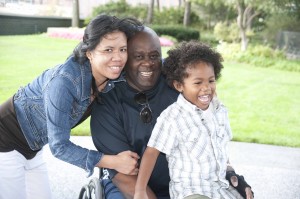 The first three years after a spinal cord injury are hardest on a marriage. That’s one of the results of a recent 15-year-study by the Department of Physical Medicine and Rehabilitation at the University of Michigan. They found that couples married at the time of an SCI were 1.3—2.5 percent more likely to get divorced than the general population during the initial three years post-injury. After that time, the divorce rate slowly lowered to the national average of about 40%. The research team interviewed 2,327 individuals with SCI who were married at the time of their injury over a period of 15 years.
The first three years after a spinal cord injury are hardest on a marriage. That’s one of the results of a recent 15-year-study by the Department of Physical Medicine and Rehabilitation at the University of Michigan. They found that couples married at the time of an SCI were 1.3—2.5 percent more likely to get divorced than the general population during the initial three years post-injury. After that time, the divorce rate slowly lowered to the national average of about 40%. The research team interviewed 2,327 individuals with SCI who were married at the time of their injury over a period of 15 years.
Participants of the 15-year-study were made up of men and women with spinal cord injuries, married at the time of their injury, and at least 18 years old. They were interviewed one year post-injury, and then at five year intervals, for 15 years. Contrary to expectations, the level of injury, function, mobility and independence did not prove to be predictors of divorce. Instead, age at injury, being Caucasian vs. African-America, having a college degree vs. high school education, having some form of employment vs. being unemployed and being in good health and involved in social life were the significant factors in preventing or delaying divorce after an SCI.
Meaningful social opportunities are especially important in predicting marriage longevity post-spinal cord injury. The researchers stated that the more time an individual with an SCI spends out of the home with friends and family, the more outlets and resources that person has separate from their non-injured spouse, the less likely they are to get divorced. The researchers suggest that outside social activities greatly lessen the burdens that come with caregiving, which in turn, promote positive communication between married couples. Social support can also benefit individuals physically and psychologically, as it lowers the emotional distress and isolation that can follow a spinal cord injury.
Here’s what Athena, who was married to her husband when he became quadriplegic at age 31 in 1996, had to say about their relationship.
Follow this link to hear more from FacingDisabiltiy Spouses.
How has a spinal cord injury affected your marriage? Leave a commitment below or connect on the FacingDisability private Facebook group.
As a hi-quad married with children, male, aged 42 at the time of my accident, I concur with some of the mentioned predictors for divorce, however I must correct it as follows:
* Of course the degree of independence is a real factor contributing to divorce.
* Financial status is also a factor, a bit more so than as before injury, many time the un-injured spouse hangs around for conclusion of a lawsuit, if one exists.
* Whether or not the injured was also the breadwinner of family will factor in as the non-earning spouse cannot easily find independence.
* The younger the marriage is and whether there’s children involved are also big factors post sci.
* The loss of intimacy is a factor contributing to divorce.
what is the study referenced in this post? title, author?
Hi Ben,
The article is called “Predictors of martial longevity after new spinal cord injury,” by Fr. D. Karana-Zebari, MB de Leon and CZ Kalpakhian through the University of Michigan.
I became a quadriplegic in 1985 and I moved out in 1987. We had a 4 year old daughter at the time. Basically, I was in denial and she met someone else. I kept it friendly for our daughter and never spoke a word of anything relating to her boyfriend or divorce. I divorced her after being apart 9 years. She got re-married and I stayed single. Oh, the one thing I left out is we were married for 6 years when the accident happened. I never shared that with anybody that didn’t know me.